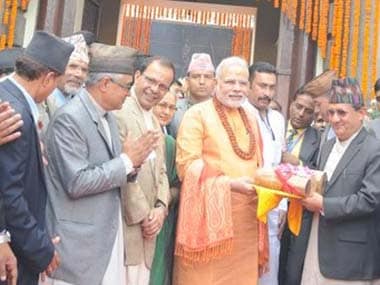Prime Minister Narendra Modi today offered puja at the famous 5th century Pashupatinath temple in Kathmandu on the second and last day of his maiden visit to Nepal. Modi was at the temple of Lord Shiva for about 45 minutes on a day which is considered pious, given that it was a Monday that falls in the month of ‘Shravan’. He donated 2500 kgs of chandan (sandalwood) to the Pashupatinath Temple trust. [caption id=“attachment_1648295” align=“alignleft” width=“380”]
 Image from Narendra Modi’s twitter feed[/caption] The Hindu temple is located on the banks of the Bagmati River in Deopatan, a village 3 km northwest of Kathmandu. It is dedicated to a manifestation of Shiva called Pashupati (Lord of Animals). It attracts thousands of pilgrims each year, mostly from India. There are a lot of Indian pujaris at the temple. The temple has also traditionally always had four priests and one chief priest from among the Bramhins of south India, for centuries. According to legend, the temple was constructed by Pashupreksha of the Somadeva Dynasty in the 3rd century BC, but the first historical records date from the 13th century. The ascetic Pashupata sect was likely related to its foundation. Pashupati was a tutelary deity of the ancient rulers of the Kathmandu Valley; in 605 AD, Amshuvarman considered himself favored by his touching of the god’s feet. By the later Middle Ages, many imitations of the temple had been built, such as in Bhaktapur (1480), Lalitpur (1566) and Benares (early 19th century). The original temple was destroyed several times until it was given its present form under King Bhupalendra Malla in 1697. According to a legend recorded in local texts, especially the Nepalamahatmya and the Himavatkhanda, the Hindu god Shiva once fled from the other gods in Varanasi to Mrigasthali, the forest on the opposite bank of the Bagmati River from the temple. There, in the form of a gazelle, he slept. When the gods discovered him there and tried to bring him back to Varanasi, he leapt across the river to the opposite bank, where one of his horns broke into four pieces. After this, Shiva became manifest as Pashupati (Lord of Animals) in a four-face (chaturmukha) linga. PTI
Image from Narendra Modi’s twitter feed[/caption] The Hindu temple is located on the banks of the Bagmati River in Deopatan, a village 3 km northwest of Kathmandu. It is dedicated to a manifestation of Shiva called Pashupati (Lord of Animals). It attracts thousands of pilgrims each year, mostly from India. There are a lot of Indian pujaris at the temple. The temple has also traditionally always had four priests and one chief priest from among the Bramhins of south India, for centuries. According to legend, the temple was constructed by Pashupreksha of the Somadeva Dynasty in the 3rd century BC, but the first historical records date from the 13th century. The ascetic Pashupata sect was likely related to its foundation. Pashupati was a tutelary deity of the ancient rulers of the Kathmandu Valley; in 605 AD, Amshuvarman considered himself favored by his touching of the god’s feet. By the later Middle Ages, many imitations of the temple had been built, such as in Bhaktapur (1480), Lalitpur (1566) and Benares (early 19th century). The original temple was destroyed several times until it was given its present form under King Bhupalendra Malla in 1697. According to a legend recorded in local texts, especially the Nepalamahatmya and the Himavatkhanda, the Hindu god Shiva once fled from the other gods in Varanasi to Mrigasthali, the forest on the opposite bank of the Bagmati River from the temple. There, in the form of a gazelle, he slept. When the gods discovered him there and tried to bring him back to Varanasi, he leapt across the river to the opposite bank, where one of his horns broke into four pieces. After this, Shiva became manifest as Pashupati (Lord of Animals) in a four-face (chaturmukha) linga. PTI
Modi offers prayers at historic Pashupatinath temple in Kathmandu
FP Archives
• August 4, 2014, 11:45:12 IST
Modi was at the Pashupatinath temple of Lord Shiva for about 45 minutes on a day which is considered pious, given that it was a Monday that falls in the month of ‘Shravan’.
Advertisement
)